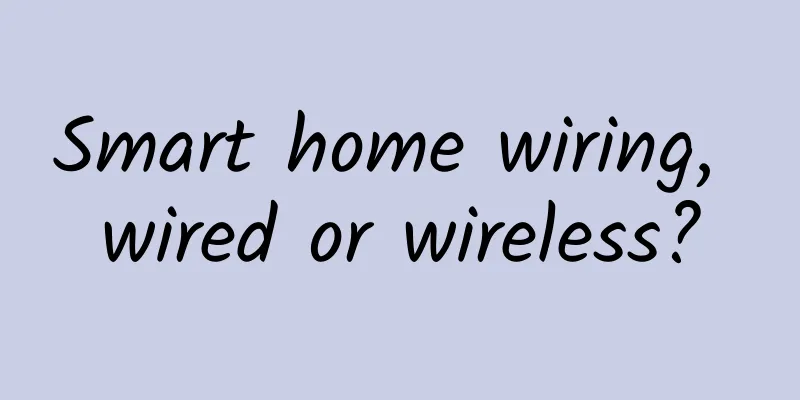Smart home wiring, wired or wireless?

|
Smart home veterans all know that wired systems are mainly promoted by foreign brands, while wireless smart home systems are promoted by local brands. So which of the two different wiring technologies is more suitable for smart homes? We will try to analyze from the following aspects. Wired and wireless transmission stability The wired wiring system of smart home is generally bus-based, supporting functions such as product series connection and duplex redundancy and disaster recovery. When a node in the system fails, the network transmission can still operate normally. In actual applications, from cable selection to point design, the wired system needs to be scientifically planned, and the design cycle is 5-10 years of stable operation, so it is not easy to have line failure problems. At the same time, the wired system has its own shielding layer and is not affected by walls, metals, and interior decorations. The anti-interference ability is much greater than that of the wireless system. In addition, its transmission distance is the same as its wiring distance, and the signal attenuation rate is very low, ensuring the stable operation of the system. Wireless systems mainly include ZigBee, Bluetooth, WiFi, ZWave, microwave (315MHz, 433MHz), cellular networks and other technologies. Different wireless technologies have their fixed characteristics, such as transmission rate, transmission distance, power consumption, anti-interference, etc. There are many common interference sources in the home environment, such as messy furniture, walls, metal decorations, etc., which will have an adverse effect on the signal. If there are many electrical appliances, it is also easy to cause high-power power supply interference; the transmission distance is also very limited, especially for large-area, multi-story houses such as villas. If there is no repeater, the signal attenuation is very obvious. This does not mean that there are many problems with wireless systems. With the current technical level and innovative solutions, many problems have been solved. It is just that it should be noted that with the changes in the environment and the extension of the application cycle, no matter how the wireless transmission technology is optimized, it cannot be guaranteed to be consistent. In general, wireless technology is not as stable as wired technology.
Wiring and smart installation transformation From the above introduction, why does China still promote wireless technology? From a cost perspective, wired wiring solutions require additional purchase of wires and require complex wiring operations. After completion, the wiring system must be hidden, requiring a large amount of manpower, material resources, and financial resources. For many consumers, this is a heavy expense. If you want to upgrade an old house to a smart home system, then more areas will need to be constructed and the cost will be higher. This is the biggest disadvantage of the wired wiring solution. However, wireless systems do not have this problem. Wireless systems can be applied to the smart upgrade and renovation of new and old houses. You only need to put the product in a fixed position and use it after coding. There is no cumbersome and labor-intensive wiring project. It has strong adaptability to environmental installation and low cost. More importantly, wireless technology has made rapid progress, with great improvements in power consumption, transmission distance, and transmission rate. Anti-interference has also been continuously enhanced, further solving users' concerns.
Comprehensive decision based on system complexity Wired has its advantages, wireless has its strengths, and it is not possible to generalize which technology should be used for both. The planning of the wiring system should be scientifically designed according to the project situation. For engineering projects and projects with particularly high requirements for stability, such as hotel projects, it is recommended to use a wired wiring system to lay a solid foundation for smart homes from the source and lay the cornerstone for a good experience in the future; and in home life, if the system function requirements are simple or the environment is relatively good, such as a smart home system with only a few devices such as smart locks and air sensors, there is no need to go to great lengths and a wireless system can be used. The advantage of wired is stability and reliability, but the large amount of engineering is its shortcoming; the characteristic of wireless is flexibility, but the shortcoming is stability. A good smart home system requires not only stability and reliability, but also flexibility in application, so as to give users the best experience. Therefore, the wiring method combining wired system with wireless system has become the design concept of high-end smart home system. Taking the smart home system of a celebrity villa as an example, the project uses wired system as the main wiring method, and the control end provides wired touch panel and wireless touch panel solutions, and provides a variety of customized mobile control terminals. At the same time, it supports mobile phone remote control. It is a comprehensive wiring solution based on bus and a combination of multiple wireless technologies. |
<<: Why is Web 3.0 important? What are the basics you need to know?
>>: Popular Science on 5G Technology and Standards You Must Know
Recommend
Can you afford a 5G terminal that costs over 10,000 yuan?
Everyone wants to be the first to experience the ...
5G manufacturing involves much more than just 5G
[[435113]] Mobile edge computing, artificial inte...
The three major operators announced their performance at the beginning of the year!
Recently, the three major operators have successi...
Huawei's cloud computing efforts drive urban cloud computing industry upgrades
[51CTO.com original article] Entering 2017, the r...
As the wave of 5G security approaches, how can we play the 5G security card well?
From 2G to 4G, mobile networks have become an ind...
ASUS releases PG27VQ gaming monitor: 165Hz, RGB light
RGB lights have now spread to every corner inside...
JuHost: $2.99/month-1GB/20G SSD/1TB@100Mbps/Kowloon, Hong Kong
JuHost has released a regular November promotion,...
The battle for 5G dominance between China and the United States: No one can retreat!
According to US media, the early wave of mobile c...
[11.11] Justhost offers a 30% discount for a limited time, with 22 data centers available in Russia, the United States, Singapore, etc.
Justhost.ru has released a limited-time discount ...
RAKsmart Double 11: San Jose servers start at $30, new users get $10 for registration, 1-10Gbps unlimited traffic servers
RAKsmart is an early-established foreign hosting ...
edgeNAT May 1st Promotion: 30% off for annual VPS and 20% off for monthly VPS, top up 500 and get 100 free, Hong Kong/Korea 2G memory package starting from 48 yuan per month
edgeNAT is a Chinese hosting company established ...
What is 5G IoT?
What is non-cellular 5G? I imagine most readers a...
Four types of network monitoring
Network monitoring can take many forms, depending...
Virtono opens new San Jose data center: KVM annual payment starts at 11.21 euros, 40% off for monthly payment
I received an email from Virtono, in which the me...









